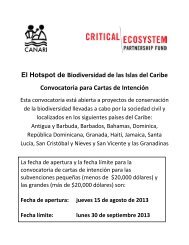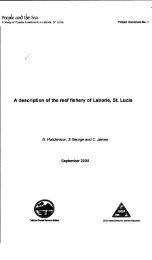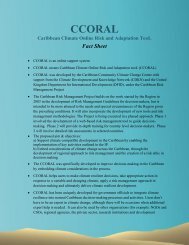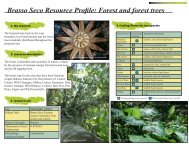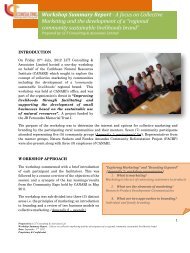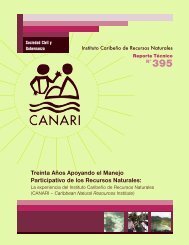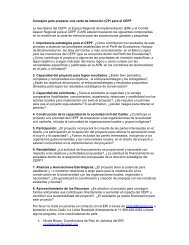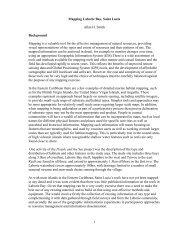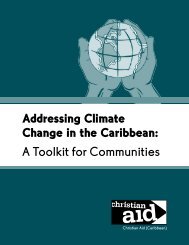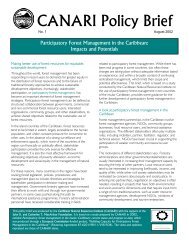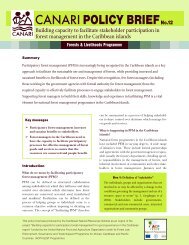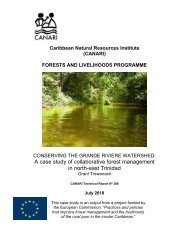Case study from Laborie Saint Lucia - CANARI
Case study from Laborie Saint Lucia - CANARI
Case study from Laborie Saint Lucia - CANARI
You also want an ePaper? Increase the reach of your titles
YUMPU automatically turns print PDFs into web optimized ePapers that Google loves.
1. Mixed economy (agriculture, fishing,<br />
commercial sector), with farming and<br />
fishing continuing to be the primary<br />
economic activities of the inhabitants.<br />
2. A natural resource base that supports<br />
traditional economic sectors (agriculture,<br />
fishing), offers potential for diversification<br />
(creative goods based on biodiversity,<br />
tourism), and is under threat (coastal<br />
pollution).<br />
3. Vulnerability to disasters, increased by<br />
climate change and degradation of the<br />
coastal environment (loss of coastal<br />
protection).<br />
4. Negative impacts of trade liberalisation on<br />
farming with economic and social<br />
consequences (poverty, migration, security<br />
issues). The main cash crop (bananas) has<br />
declined greatly in recent years as a result<br />
of the loss of preferential access to<br />
European markets, causing drastic<br />
reductions in production and export.<br />
5. Unfulfilled tourism promises such as hotel<br />
developments that have not materialised.<br />
6. Geographic marginalisation: although <strong>Saint</strong><br />
<strong>Lucia</strong> is small, much of the economic activity<br />
centres on the north of the island, and<br />
current development initiatives and trends<br />
tend to exacerbate geographic disparities.<br />
Perhaps one of the distinctive features of this<br />
community is that it has significant social<br />
capital, with strong community institutions,<br />
including a vibrant Co-operative Credit Union<br />
that has been in existence since 1976. With<br />
1200 members and assets of around US$30<br />
million, it is currently the leading community<br />
financial institution in <strong>Saint</strong> <strong>Lucia</strong>. It provides<br />
employment and all main banking services,<br />
including education, housing and business<br />
loans.<br />
b. Community-based development planning<br />
In 1999 a small group of local residents and<br />
organisations with an interest in sustainable<br />
development and dissatisfied with conventional<br />
development approaches, took the initiative to<br />
facilitate the participatory formulation of a<br />
Strategic Development Plan for <strong>Laborie</strong>. The<br />
decision was made in response to a government<br />
programme, known as Comfort 2000, which<br />
aimed at supporting community-based projects<br />
in all towns and villages in the country. Financial<br />
and technical assistance was sought and<br />
received <strong>from</strong> the <strong>Saint</strong> <strong>Lucia</strong> Heritage Tourism<br />
Programme for a process that involved two<br />
years of consultations and studies aimed at<br />
identifying issues and opportunities for the<br />
integrated development of the <strong>Laborie</strong> village<br />
and surrounding communities. An ad hoc<br />
<strong>Laborie</strong> Development Planning Committee<br />
(approximately 25 people, representative of all<br />
main sectors and social groups) coordinated this<br />
participatory planning process. The plan was<br />
finalised and published in December 2001.<br />
The plan offered the vision of “a culturally<br />
vibrant community where there is continuous<br />
improvement in the quality of life and where<br />
people are able to enjoy all the basic necessities<br />
and to participate fully in the process of<br />
development”. The plan is structured along<br />
several strategic directions, including:<br />
participation; uniqueness and competitiveness;<br />
economic linkages and integration;<br />
encouragement of self-help, autonomy and<br />
initiative; strengthening of community<br />
organisations; and cultural development, and it<br />
includes five sectoral plans (education and<br />
human resources; health care and social<br />
services; agriculture and fishing; tourism; and<br />
youth and sports).<br />
At the end of this process and in accordance<br />
with the provisions of the strategic plan, a new<br />
institution, the <strong>Laborie</strong> Development<br />
Foundation, was established, building on the<br />
experience of the <strong>Laborie</strong> Development<br />
Planning Committee, as the primary<br />
institutional arrangement for the coordination<br />
of the implementation of the strategic plan. The<br />
Foundation was formally registered in<br />
December 2002 as a not-for-profit company. Its<br />
members are community organisations that<br />
have a primary focus on <strong>Laborie</strong>. At present,<br />
2



